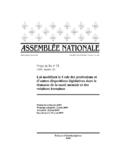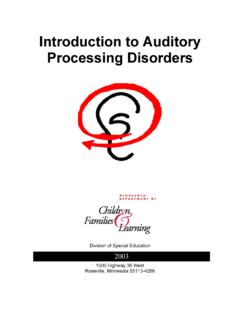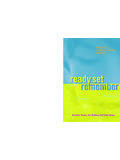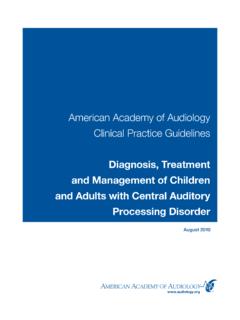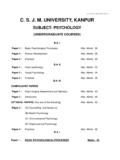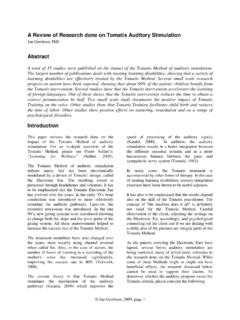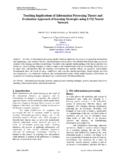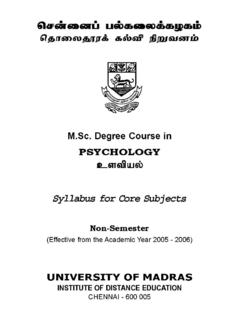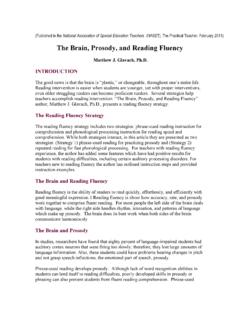Transcription of Canadian Guidelines on Auditory Processing …
1 Canadian Guidelines ON Auditory Processing DISORDER IN CHILDREN AND ADULTS: ASSESSMENT AND INTERVENTIOND ecember 2012 Canadian Association of Speech-Language Pathologists and Guidelines on Auditory Processing Disorder in Children and Adults: Assessment and Intervention 2 Table of Contents Table of Contents .. 2 Disclaimer .. 4 Interorganizational Steering Group for Speech Language Pathology and Audiology .. 4 Update and review .. 4 Changes to web links .. 4 Author sub- committee .. 4 Acknowledgements .. 4 Executive Summary .. 5 CHAPTER 1 .. 6 INTRODUCTION AND FRAMEWORK .. 6 Introduction .. 6 Moving to a 21st century perspective.
2 6 Working within a theoretical framework for the Canadian context .. 7 Guideline consumers .. 8 CHAPTER 2 .. 10 GUIDING PRINCIPLES, DEFINITIONS AND COMPETENCIES .. 10 The International Classification of Functioning, Disability and Health .. 10 Body functions and structures .. 10 Activity and participation .. 11 Contextual factors .. 11 Environmental factors .. 11 Personal factors .. 11 Professionals involved in assessment and management of Auditory Processing disorder .. 13 Definition of Auditory Processing disorder .. 13 Prevalence of Auditory Processing disorder.
3 14 Clinical competencies .. 15 Clinical knowledge base .. 15 Knowledge of community resources .. 16 CHAPTER 3 .. 17 ASSESSMENT AND MANAGEMENT OF CHILDREN WITH Auditory Processing DISORDER .. 17 Indications for referral .. 17 Personal factors .. 18 Age .. 18 Cognitive, developmental, personality and learning disorders .. 18 Peripheral hearing loss .. 19 Screening .. 20 Assessment of Auditory capacities .. 20 Pre- assessment information gathering and case history .. 21 Tools for assessment of Auditory capacity .. 21 Interpretation of Auditory capacity test assessment.
4 23 Delay vs. disorder .. 25 Re- evaluation .. 25 Intervention to improve participation .. 25 Environmental factors to improve participation .. 27 Physical environmental factors .. 27 Canadian Guidelines on Auditory Processing Disorder in Children and Adults: Assessment and Intervention 3 Partnership with the classroom teacher and school staff .. 27 Acoustics of the environment .. 28 Assistive listening devices .. 28 Social environmental factors .. 30 Support, relationships and attitudes .. 30 Services, systems and policies .. 30 Personal factors to improve participation.
5 31 Improving Auditory capacities by direct intervention .. 31 Improving the child s ability to be active in communication and learning .. 32 CHAPTER 4 .. 34 ASSESSMENT AND MANAGEMENT OF Auditory Processing DISORDER .. 34 IN ADULTS .. 34 Introduction .. 34 Indications for referral .. 35 Personal factors .. 35 Age .. 35 Cognition .. 36 Tumours .. 37 Cerebrovascular disorders or stroke .. 38 Traumatic brain injury .. 38 Epilepsy .. 39 Solvent exposure .. 40 Demyelinating disorders and neurodegenerative diseases .. 40 Genetics .. 41 Peripheral hearing loss.
6 41 Assessment of Auditory capacities and performance .. 42 Pre- assessment information gathering and case history .. 42 Tools for assessment of Auditory capacity .. 43 Interpretation of Auditory capacity test assessment .. 45 Re- evaluation .. 45 Intervention to improve participation .. 45 Environmental factors .. 48 Physical environmental factors .. 48 Partnerships in the workplace, home and community .. 48 Acoustics of the environment .. 49 Assistive listening devices .. 49 Social environmental factors .. 51 Support, relationships and attitudes .. 51 Services, systems and policies.
7 51 Personal activities to improve Auditory performance .. 52 Improving Auditory capacities through direct training .. 53 Improving the individual s ability to be active in the communication process .. 54 CHAPTER 5 .. 56 CONCLUDING REMARKS AND FUTURE DIRECTIONS .. 56 Conceptualizing and researching the construct of Auditory Processing disorder .. 56 Training clinicians and facilitating continued learning .. 58 Providing, enhancing and coordinating effective services for clients .. 59 REFERENCES .. 61 Canadian Guidelines on Auditory Processing Disorder in Children and Adults: Assessment and Intervention 4 Disclaimer While every effort has been made to ensure the accuracy of the content of these Guidelines , neither the authors nor the Interorganizational Steering Group for Speech- Language Pathology and Audiology accept any liability with respect to loss, damage, injury or expense arising from any errors or omissions in the contents of this work.
8 Interorganizational Steering Group for Speech Language Pathology and Audiology The Canadian Interorganizational Steering Group for Speech- Language Pathology and Audiology is composed of: the Canadian Alliance of Audiology and Speech- Language Pathology Regulators (CAASPR), the Canadian Association of Speech- Language Pathologists and Audiologists (CASLPA) and the Canadian Academy of Audiology (CAA), representing the professional associations and the Canadian Council of University Programs (CCUP) in Communication Sciences and disorders . Their mandate is to coordinate the work of regulatory bodies, professional associations and universities on projects/activities of mutual benefit and interest for the betterment of the professions of speech- language pathology and audiology and to collaborate on the development of practice standards and Guidelines .
9 Update and review It is recommended that the content of this document be reviewed and updated every three years, or as required based on substantial changes in research and practice in the area of assessment and management of Auditory Processing disorders . Changes to web links Website addresses in this document were accessed as of the time of printing. Web addresses change frequently and links may break. Linked documents are not under the control of the Interorganizational Steering Group for Speech- Language Pathology and Audiology. The Interorganizational Steering Group is not responsible for the contents of any linked sites, including without limitation any link contained in a linked site or updates to a linked site.
10 Author sub- committee Pam Millett, PhD, York University, Ontario. Chair Beno t Jutras, PhD, University of Montreal, Quebec Greg Noel, , Nova Scotia Speech and Hearing Centres, Nova Scotia Kathy Pichora- Fuller, PhD, University of Toronto, Ontario Charlene Watson, , Richmond Road Diagnostic & Treatment Centre, Alberta Arden Nelson, , ABC Children's Audiology & Hearing Services, Manitoba (preparation phase) Acknowledgements The author sub- committee would like to thank the reviewers of drafts of this document: Dr. Larry Humes (Indiana), Michelle Parker (Ontario) and Barb Hardcastle (Alberta). Canadian Guidelines on Auditory Processing Disorder in Children and Adults: Assessment and Intervention 5 Executive Summary The Canadian Guidelines for Assessment and Management of Auditory Processing Disorder in Children and Adults project was initiated by the Canadian Interorganizational Steering Group for Audiology and Speech- Language Pathology, and created the first national Guidelines developed for Canada.
